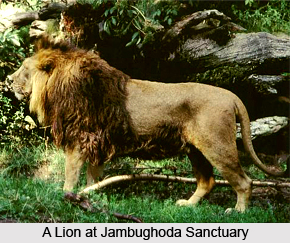 Jambughoda Wildlife Sanctuary is a renowned wildlife sanctuary which is situated in Jambughoda Taluka, Panchmahal District of Central Gujarat, at a distance of nearly 70 kms away from Vadodara and 20 kms from the regions of Champaner and Pavagadh. The total area covered by this sanctuary is nearly 130.38 square kilometres and was proclaimed a sanctuary during May 1990. A tiny portion of Jambughoda Wildlife Sanctuary known as Targol Round is included in the Princely State of Jambughoda before the Indian independence from the British Raj. There exists undulating hills in this place which are inhabited by humans and some of the thrilling tourist locales present close to the sanctuary include Jhand Hanuman Temple, Targol and Kada.
Jambughoda Wildlife Sanctuary is a renowned wildlife sanctuary which is situated in Jambughoda Taluka, Panchmahal District of Central Gujarat, at a distance of nearly 70 kms away from Vadodara and 20 kms from the regions of Champaner and Pavagadh. The total area covered by this sanctuary is nearly 130.38 square kilometres and was proclaimed a sanctuary during May 1990. A tiny portion of Jambughoda Wildlife Sanctuary known as Targol Round is included in the Princely State of Jambughoda before the Indian independence from the British Raj. There exists undulating hills in this place which are inhabited by humans and some of the thrilling tourist locales present close to the sanctuary include Jhand Hanuman Temple, Targol and Kada.
Flora of Jambughoda Wildlife Sanctuary
Different kinds of flora are found in Jambughoda Wildlife Sanctuary comprising Dudhalo, Bamboo, Sadad, Mahuda, Timru, Sag, Dhav, Bor, Khair, Bili, Teak, Shisham and many others. Several portions of this sanctuary are filled with Southern Dry Tropical Rain Forests, Mixed Deciduous Forests, Secondary Dry Deciduous Forests, Dry Deciduous Scrub Forests and so on. The mahuda trees of this region serve as excellent sources of food for the wild creatures and also the human settlements based here.
Fauna of Jambughoda Wildlife Sanctuary
Leopard, Wild Boar, Jungle Cat, Wolf, Sloth Bear, Barking Deer, Bluebull, Four-Horned Antelope, Indian Porcupine, Jackal, Hyena, Crocodile, Indian Civet, Mongoose, Python are amongst the various kinds of diverse wildlife existent in Jambughoda Wildlife Sanctuary. Many species of rodents are also observed frolicking in the vast campus of this sanctuary. Poisonous as well as non-poisonous snakes also dwell inside the sanctuary grounds. Visitors will be greeted by the constant chirping of numerable attractive birds in this wildlife reserve. In the olden days, a large number of Jungle Fowls used to roam about freely in the premises of the sanctuary. However, presently this species is on the verge of extinction and is hardly noticed here.
It is advised that the months of winter are perfect if travellers are looking forward to approaching this wildlife sanctuary. The time between November and March is considered the best time to visit this place.



















